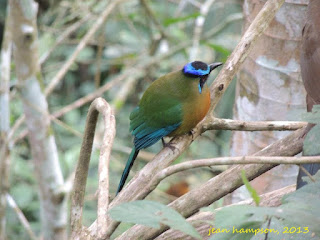In my last post, I had mentioned that the Blue-Crowned Lesson's Motmot was lifer #435 for Jean and I. I soon became dismayed upon the realization that we had observed only 20 lifers since then. 20 lifers in 3 years and 3 months. Half of which occurred in the remaining months of 2013.
I really shouldn't be lamenting.The twenty lifer ticks have been impressive and unique. But like most birders, I'm always looking for the next addition. A recent attempt at adding Barred Owl to our life list was unsuccessful. Our friend Marcie had made arrangements with a property owner in southern Niagara for a small group of birders to view a family of Barred Owls after she had viewed them a few days earlier. It was the evening of July 3 and also our wedding anniversary but Jean and I brought our hiking/birding clothes with us to change into after our dinner. We did not rush through our excellent meal and made it to the location well before sunset. Shortly after dusk, there were fireworks heard in the distance but no "who cooks for you?" call on the forested property.
Our next opportunity at adding a lifer came Wednesday afternoon earlier this week. Eric Holden had observed Black-bellied Whistling Ducks on the beach at Bayfront Park in Hamilton. During our last visit to the municipal park in January 2012, we dipped on a reported Black-throated Gray Warbler on the Waterfront Trail.
Hamilton is a short drive from St. Catharines. In under an hour we reached the park located on Burlington Bay and as Jean and I walked along the paved path towards the beach, there were a few Pokémon Go searchers with their iPhones in hand but no one sporting binoculars. Kenn Kaufmann wrote an interesting article on this newest craze.
We were given some reassurance when Jean and I ran into a birder on his way out and he told us that the ducks were still there. Upon arriving at the reported location, we could see them amongst the small crowd of Ring-billed Gulls on the sandy beach.
Along with a few other birders, we had great views of a species (commonly found on the gulf coast of the United States) that had not been observed in the Hamilton Study Area prior to July 13, 2016. A first! And a lifer added to our ABA, Ontario and Hamilton lists.
The ducks were disturbed by two guys walking on the beach from the opposite direction. They flew west and landed in the bay approximately one kilometre from our location. Luckily for birders still en route, the ducks returned to the beach after being disturbed by pleasure craft on the water.
The Black-bellied Whistling Ducks were resting on the beach when Jean and I left and shortly after, the ducks vacated Bayfront Park and have not been reported since then. We're glad we chose to go the same day of the report and I can return to working on the Niagara year list feeling more than content with a rare lifer tick.









